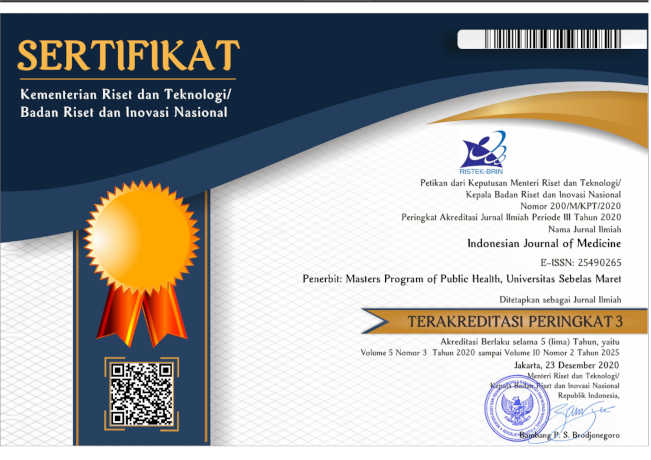Therapy of Cinnamon Decoction using Honey in Reducing Gout
DOI:
https://doi.org/10.26911/theijmed.2019.4.1.153Abstract
Background: Gout is an antioxidant, the final product that is produced from the metabolism/ breakdown of purines, but if in excessive amounts in the blood, it will experience crystallization and can cause gout. Giving cinnamon extract to male white rats with hyperuricemia has the effect of reducing uric acid levels, because the extract of cinnamon contains Polyphenols namely Sinamldehid which is high enough (68.65%) to be a source of antioxidant compounds which can inhibit Xanthine Oxidase Enzine. This study aimed to analyze the therapy of dekokta cinnamon with honey to reduce uric acid for people with gout.
Subjects and Method: This was a quasi experiment with pre and post-test design. The study was conducted in Gambirsari Community Health Center, Kadipiro Subdistrict, Mojosongo, Surakarta, Central Java, in May 2018. A sample of of 50 people with gout sufferers were selected by quota sampling and divided into 2 groups. The treatment group of 25 people received cinnamon decoction with honey with a concentration of 15%. The therapy was carried out for 1 week with a dose of once a day. In the control group, Allopurinol 100 mg was given for 1 week, with a dose of once a day. The data were analyzed by Wilcoxon and Mann-Whitney est.
Results: Uric acid in decoction cinnamon with honey group was lower than in control group and it was statistically significant (p= 0.023).
Conclusion: Decoction cinnamon with honey can reduce uric acid level among gout patients.
Keywords: cinnamon, decoction, honey, gout
Correspondence: Yeti Nurhayati. Nursery Program, School of Health Sciences Kusuma Husada, Surakarta, Central Java. Email: yeti_nurhayati234@yahoo.com.
Indonesian Journal of Medicine (2019), 4(1): 35-39
https://doi.org/10.26911/theijmed.2019.04.01.06
References
Chayati I, Miladiyah I (2014). Kandungan komponen fenolat, kadar fenolat total, dan aktivitas antioksidan madu dari beberapa daerah di Jawa dan Sumatera. Jurnal Media Gizi Masyarakat Indonesia, 6 (1): 11-24. Google Scholar
Khanna et al. (2012). Guidelines for management of gout. Part 1: Systematic Nonpharmacologic and Pharmacologic Therapeutic Approaches to Hyperuricemia, American College of Rheumatology. 64(10): 1431-1446. doi: 10.1002/acr.21772 Crossref PubMed Google Scholar
Lina N, Setiyono A (2014). Analisis kebiasaan makan yang menyebabkan peningkatan kadar asam urat. Jurnal Kesehatan Komunitas Indonesia. 10(2). Google Scholar
McCrudden FH (2000). Uric acid: The chemistry, physiology and pathology of uric acid and the physiologically important purin bodies, with a discussion of the metabolism in gout. Google Scholar
Tukiyo IK, Hasan H, Mustapa MA (2014). Uji efek antiuresemia ekstrak etanol kayu manis (Cinnamomum Burmanii) pada tikus putih jantan (Rattus Novergicus). Google Scholar
Shekar M, et al. (2012). Evaluation of in vitro antioxidant property and radio protective effect of the constituent medicinal plants of a herbal sunscreen formulations. International Journal of Pharmaceutical Frontier Research (IJPFR). 2(2): 5. Google Scholar











